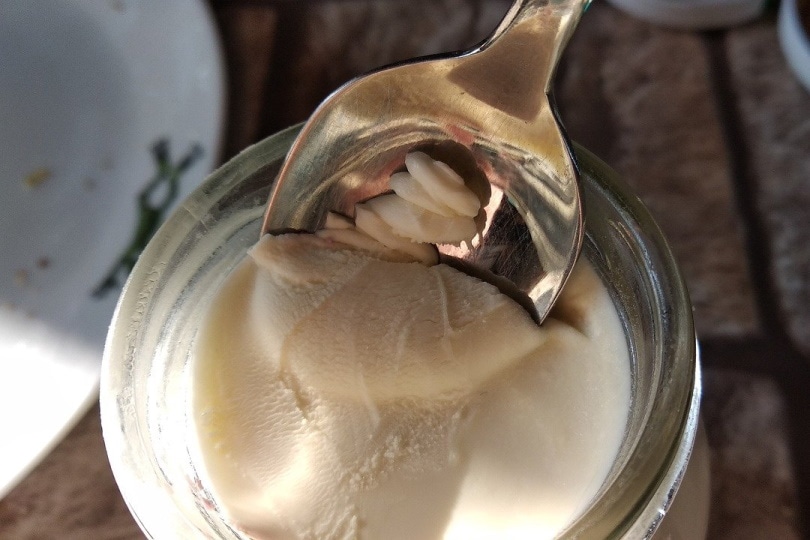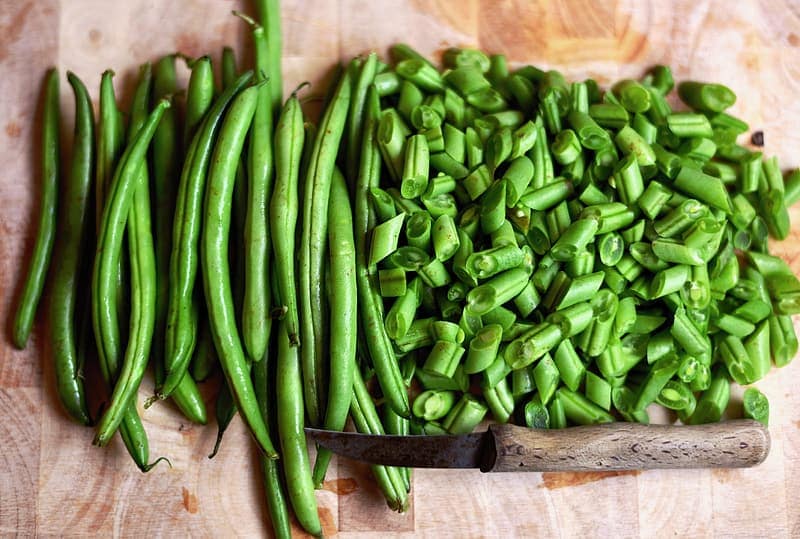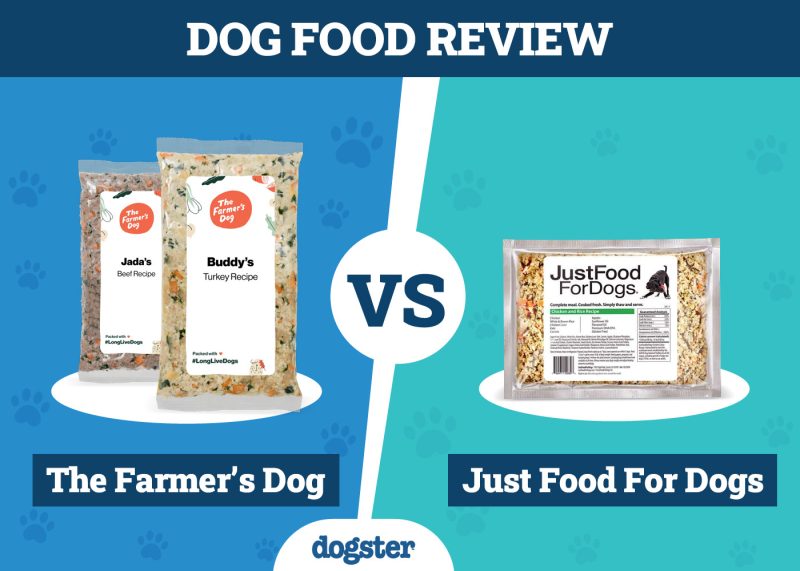In this article
If you’re like most dog owners, you want what’s best for your furry friend, including a healthy diet with plenty of nutrients and protein. But, should your pup eat only the same dry food day in and day out? Absolutely not! While not everyone can change to a fresh diet due to the cost, one option is to mix their dog food with other ingredients. Providing variability as well as less processed foods is important. While not every ingredient will suit every dog in a given situation, we will discuss 25 great foods that can be mixed with dry dog food to make it more appealing to your pet!
Just remember that your dog’s nutrition should come from a complete and balanced formula so ensure they eat at least 90% of their daily calories from a balanced diet, and then you can add the remaining 10% of their calories from mixers. This way you can ensure they get all the nutrition that they need without exceeding their daily caloric allowance.

Top 25 Options to Mix With Dry Dog Food
1. Wet Dog Food
Wet dog food is an excellent option for mixing with dry food. It can add moisture and flavor to the dish, making it more appealing to your pet. Plus, it’s packed with nutrients and protein your dog needs for a healthy diet.

2. Dog Treats
Dog treats are a great way to add variety to your dog’s diet. You can use them as a topping for dry food or mix them with the food. Either way, your dog will love the added flavor, and you’ll know they’re getting a nutritious meal.

3. Canned Pumpkin
Canned pumpkin is an excellent source of fiber and nutrients, making it a perfect addition to dry dog food. It can add moisture and flavor to the dish, and your dog will love the sweetness. Plus, it’s a healthy way to add variety to their diet.

4. Peanut Butter
Peanut butter is a favorite of many dogs. It’s a great source of protein and can make dry food more palatable. Just be sure to use all-natural peanut butter without added sugar, artificial sweeteners, or salt. Be especially aware that a commonly used sweetener, Xylitol, is toxic to dogs.

5. Cooked Chicken
Cooked chicken is another great option for adding protein and flavor to dry food. You can shred or chop the chicken into small pieces before adding it to the food. Chicken provides your dog with essential nutrients and is a lean source of protein.

6. Broth
Broth is a great way to add moisture and flavor to dry food. You can use chicken, beef, or vegetable broth. Simply pour a little bit into the food and mix it well. Just ensure that the broth is prepared without including onion, garlic, chives, or leeks, which are toxic to dogs. You should also avoid excessive salts.

7. Commercial Dog Food Toppers
Commercial dog food toppers are a great way to add flavor and nutrition to dry dog food. Just be sure to choose one appropriate for your dog’s age, breed, and activity level.

8. Cooked Beef
Cooked beef is another protein-rich option for dry food. You can chop or grind the beef into small pieces before adding it to the food. Beef is a great source of protein and provides your dog with the energy they need.

9. Liver
Liver is high in protein, iron, and vitamins A and D, making it an excellent addition to dry dog food. If your dog is not on a raw diet, you should cook the liver before adding it to the kibble or mixing it with wet food.
10. Cheese
Cheese is another great way to add flavor and nutrition to dry dog food. Just be sure to choose a modest amount of cheese and one that is low lactose and safe for dogs, such as cheddar or Swiss. You can add the cheese to the food or shred it into small pieces. Avoid feeding cheese every day as it is high in fat and calories, which can lead to weight gain and all the health problems that might come with it.

11. Greek Yogurt
Plain greek yogurt is an excellent source of protein, calcium, and probiotics, making it a perfect addition to dry dog food. One or two spoons can give that kibble a fun twist. Just be sure to choose a yogurt that is plain, natural, and safe for dogs without added flavors, sugar, or artificial sweeteners.

12. Eggs
Eggs can be a healthy and nutritious addition to your dog’s diet. They are an excellent source of protein, and they also contain essential fatty acids that keep your dog’s coat glossy and healthy. Just be sure to feed your dog in-shell pasteurized eggs or eggs that have been properly cooked to avoid the risk of food poisoning.

13. Salmon
Salmon is a great source of omega-3 fatty acids, which are beneficial for your dog’s coat, skin, and overall health. Please ensure the salmon is baked or grilled as raw salmon should never be fed to dogs. Alternatively, you can add canned salmon (in water) to dry food or mix it with wet food.

14. Sweet Potatoes
Sweet potatoes are a nutritious addition to dry dog food. They are a source of carbohydrates, antioxidants, vitamins, minerals, and fiber. You can bake or mash the sweet potatoes before adding them to the food.

15. Green Beans
Green beans are a healthy vegetable that can be mixed with dry dog food. They provide some proteins and are low in calories and high in fiber. You can cook the green beans and chop them up before adding them to the food.

16. Carrots
Carrots are another healthy vegetable that can be mixed with dry dog food. They are a good source of carbohydrates, antioxidants, vitamins, minerals, and fiber. You can offer them raw or cooked, pureed, shredded, or chopped into small pieces before adding them to the food.

17. Apples
Apples are a healthy fruit that can be mixed with dry dog food. They are a good source of carbohydrates, antioxidants, vitamins, minerals, and fiber. You can chop or slice the apples before adding them to the food.

18. Cottage Cheese
Cottage cheese is another healthy source of protein and calcium, and it can also add moisture to dry food. Just be sure not to offer more than a spoon as this contains a moderate amount of lactose and many dogs are lactose intolerant. Also, choose cottage cheese that doesn’t contain salt or artificial flavors, as these can be harmful to dogs in large quantities.

19. Pork
Pork is an excellent source of protein and nutrients, making it an excellent complement to dry dog food. Cook the pork thoroughly before adding it to the kibble or combine it with wet food. Look for low-fat cuts of pork, as some cuts are too fatty for dogs.

20. Lamb
Lamb is another protein-rich option for dry dog food. If your dog is not on a raw diet it is best to gently cook the lamb before adding it to the food or mix it with wet food. Be sure to remove any bones before feeding it to your dog.

21. Flaxseed Oil
Flaxseed oil is a great way to add energy from healthy fats to dry food. While dogs are not as efficient as humans in converting alpha-linolenic acid (ALA) to the more famous and beneficial Omega-3 fatty acids docosahexaenoic acid (DHA) and eicosapentanoic acid (EPA), they can still convert about 10% of it. Simply add a few drops to the food and mix it well.

22. Coconut Oil
Coconut oil is another healthy fat that can be used to add flavor and some extra energy to dry dog food. Simply add a teaspoon or two to the food and mix it well.

23. Quinoa
Quinoa, like amaranth and buckwheat, is a gluten-free grain that can be added to dry dog food. It’s high in protein, vitamins, and minerals. Quinoa must be cooked before being mixed into the dry dog food.

24. Oatmeal
Oatmeal is a healthy grain that can be mixed with dry dog food. It is a source of carbohydrates and fiber. You should cook the oatmeal to a soft, soupy consistency before adding it to the food.

25. Tuna
Tuna is another protein option to use infrequently to top up your dog’s dry food. You can add canned tuna (in water) to the food or mix it with wet food. The reason tuna is near the end of our list is due to concerns with heavy metal accumulation. It is something most households have in the pantry but something to be offered only on some occasions.


What to Look for in a Dog Food Additive?
When choosing a food topper for your dog, since dry food is already high in carbohydrates it is best for your dog to focus on protein mixers. You also want to ensure that the topper doesn’t contain any artificial flavors or colors, as these can harm dogs. Additionally, you’ll want to choose an appropriate food for your dog’s age, weight, and activity level, considering the calories that it will provide. If you’re unsure which is right for your dog, talk to a veterinarian. They will recommend the best option for your furry friend.
If you need to speak with a vet but can't get to one, head over to PangoVet. It's our online service where you can talk to a vet online and get the personalized advice you need for your pet — all at an affordable price!

Foods You Should NEVER Give Your Dog
There are some foods that you should never give your dog since they can be harmful or even fatal. These include:
- Chocolate
- Grapes
- Raisins
- Onions
- Garlic
- Avocados
- Coffee
- Macadamia nuts
- Xylitol (a sugar substitute)
- Processed snack foods
- Alcohol
If you’re ever unsure whether food is safe for your dog, it’s best to err on the side of caution and avoid giving it to them. If you have any questions, be sure to talk to a veterinarian.

Will Mixing Things With My Dog’s Food Cause Weight Gain?
If you’re concerned about your dog’s weight, you may wonder if adding toppers to their food will cause them to gain weight. The truth is that it depends on the ingredients you’re adding and how much your dog is eating. For example, adding cooked chicken or cottage cheese may not cause weight gain, as they are low in calories and high in protein. On the other hand, adding too much cheese or olive oil can cause weight gain. Be sure to consider the number of calories you add to your dog’s diet.
This handy calculator can help you figure out the approximate amount of calories your dog should eat. You should also consider their base calories by calculating the amount of food they normally eat in a day. The idea is to substitute 10% of the calories, not to overfeed them.
The exact amount of calories an individual animal needs to maintain a healthy weight is variable and influenced by many factors including genetics, age, breed, and activity level. This tool is meant to be used only as a guideline for healthy individuals and does not substitute veterinary advice
Aren’t Dogs Lactose Intolerant?
While some dogs are intolerant to lactose, that doesn’t mean that all dogs can’t eat dairy. Many dogs enjoy eating cheese and yogurt. If you’re unsure whether your dog can tolerate dairy, it’s best to start with the minimum amounts and observe them closely. If you are unsure, talk to a veterinarian.
Should I Be Adding Supplements to My Dog’s Food?
If you’re feeding your dog a food that says “balanced and complete” on the label, then you shouldn’t need to add any supplements. However, just like us, dogs will benefit from some variability and they shouldn’t be expected to eat only the same dry food every day of their lives.
Feeding your dog a healthy, balanced diet is important for their overall health and wellness. By adding some of these ingredients to their food, you can make sure they’re getting some variability and benefit from eating some less processed ingredients. Just be sure to talk to a veterinarian first, so you can choose the best option for your furry friend.

Is It Safe to Give My Dog Bones?
Ground bones are a great way to add extra nutrients and minerals to your dog’s diet, while complete bones can also be used as enrichment, but it’s essential to ensure they’re safe. Never offer your dog cooked bones as they can splinter and break, which can cause serious harm (or even death) if your dog swallows them. For that reason, it’s best to avoid giving your dog bones unless you’re sure they’re safe. If you decide to give your dog bones, supervise them closely and remove any small pieces that may break off. Also, be wary of the potential for tooth fractures! Additionally, it’s essential to consider your dog’s chewing behavior, jaw size, and tooth condition before deciding if offering them bones is safe and worth it.

Conclusion
Several healthy foods can be mixed with dry dog food to provide additional nutrition and flavor. Adding just a few simple ingredients can create an enticing and delicious meal for your dog. Just be sure to avoid adding anything listed as toxic for them or with excess salt or artificial flavoring. When possible, protein-based mixers are preferred as dry food provides a lot of carbohydrates. With a bit of creativity, you can create various meals that your dog will love. Try some of these suggestions and see what works best for your furry friend.
Related Reads:
- American Corgi vs Pembroke Welsh Corgi: How to Tell Them Apart
- F1 vs. F2 Goldendoodle: The Differences (With Pictures)
Featured Image Credit: marialevkina, Shutterstock





















